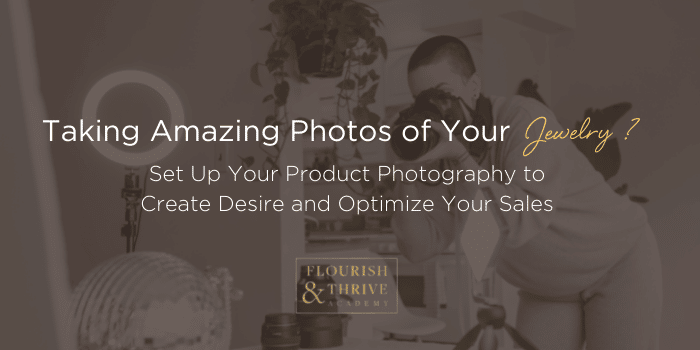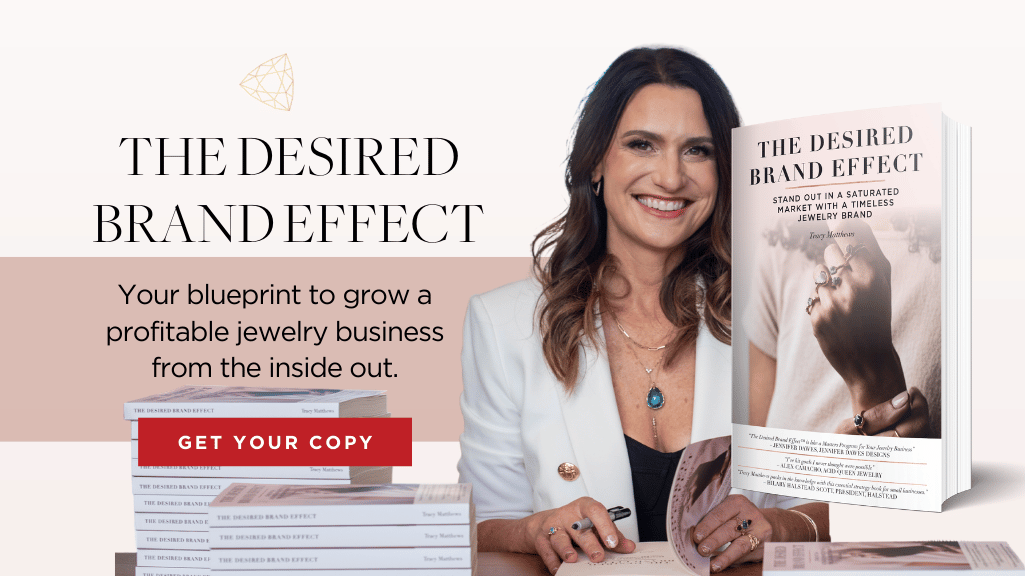Taking Amazing Photos of Your Jewelry

Set Up Your Product Photography to Create Desire and Optimize Your Sales
If you’ve never really paid much attention to how you photograph your jewelry, consider this your crash course in photography basics every small business owner should know.
Set Yourself Up for Success
I’m a huge advocate for doing things right. It’s all over my messaging, my ethos in life, and the reason I started Flourish & Thrive Academy in the first place. If you know me, you already know how much importance I place on what your business needs to succeed.
We’ve put together some great templates for the fundamental assets every ecommerce business needs. If you take advantage of these resources, you’ll be leagues ahead of all the business owners who are just guessing.
Before you jump into photography, don’t overlook the vital areas of your biz that need to be set in order to get the most out of stellar product photos.
You’re ready to optimize your photos if…
- You’ve put time into building your website – you know where and how to sell your product.
- You’ve meticulously curated your brand image.
- You’ve planned your marketing campaign for the products. You’re proud of the collection you’ve put together. It’s high impact, and, frankly, fabulous.
- You know how you’re going to woo your dream client with your designs, and you’re preparing for a great season of connecting with your customers and raking in sales.
Your Visual Assets Create Desire
But… even when you do all these things, sometimes sales still don’t pan out the way you want them too. Sometimes it can feel like everything’s static.
Your conversion rate is low, and the bounce rate to your site is high – your prospects lose interest pretty quickly, and it’s obvious that your product’s not having the impact you hoped for.
I’m gonna share something with you that took me years to learn: often the answer to a complicated problem is much simpler than you think.
Before you grab at radical solutions, or start to believe that you’re not good enough as a designer, take a step back and look at your brand from a customer’s point of view.
Ask yourself: does your photography communicate the true value of your jewelry?
Your product photography can have a major impact on the first impression you create for your potential customers. The result can make or break your brand image.
Pay Attention to the Small Details, M’dear.
Yes, it’s crucial to get product photography right.
There’s no need to stress yourself out over this. You definitely don’t need cutting-edge equipment or expensive props in order to achieve product photos that wow your customers. More on that later.
First, you need to understand the effect product photography has on a potential buyer.
The Message Your Brand Sends to the Consumer
Your brand photographs are a key element of your brand assets, which set the tone for what your customers can expect from you.
Effective brand assets:
- Keep you top of mind in the industry.
- Stand as a visual representation of your brand.
- Encompass everything you use to promote your business, including your images, photography, line sheets, and catalogs.
When you get this right, you will have a cohesive brand that your audience can recognize and connect with.
The 3 Categories of Brand Photography
There are three different types of brand photography, and each has a place in your business. What counts is knowing when and where to use each type to convey a consistent message to your audience and influence people to buy from you.
Product Photography
Your product photography should be simple and consistent. Just a high quality photo of your product on a plain white background, well lit to showcase the details. It’s best to capture multiple angles and close-ups.
Use these photos on your website product pages and wholesale linesheets.
Model Photography
Model photography is a step above plain product photography, as it showcases your jewelry worn on models. However, the main focus of the shot should still be on your jewelry.
Model shots are great to feature after your product shots on your product page. They also make for great social media content.
Lifestyle Photography
Lifestyle photography is less about showcasing the details of your jewelry and more about helping your audience envision themselves wearing it. These tend to be the most creative and “artsy” of the three photography types.
There are no strict rules for lifestyle shots, and they help to communicate the overall vibe of your brand. Lifestyle photography is perfect for lookbooks, social media, and the main pages of your website.
Now that we’ve covered your visual assets, your messaging, and the 3 types of brand photography, let’s dive into the nitty gritty photography specifications that will make your photos pop.
The Basic Equipment You Need to Take Great Photos
Nothing kills a potential buyer’s interest like low-res, unprofessional product photography. It can make your jewelry look cheap and poorly made, even when it’s not.
As I said before, you really don’t need any fancy equipment to achieve professional product photos. In fact, most recent smartphone cameras could probably make the cut. But if you want to take it a step beyond, investing in a decent camera will really elevate your photography to the next level.
With this in mind, you’re probably wondering what you need to get started.
Your Camera
Your product images are likely to be small to conform to online image standards.
Try to avoid using compact or point-and-shoot cameras – you can’t get the kind of picture quality product photography requires.
A mid-level DSLR camera is enough to give you the quality you’re after.
There may be a bit of a learning curve at first, but take the time to do research and practice. You’ll be amazed how quickly your skills and confidence can improve with just a little dedication.
Your Camera Lens
When it comes to photographing tiny products, like jewelry, pros recommend purchasing a macro lens with a focal length of 60 mm.
Kit lenses, typically between 18mm and 55mm (wide angle, short zoom), aren’t ideal for really small objects. They’re better suited to lifestyle photography, like capturing jewelry models in specific settings.
The 60mm macro lens is a standard lens that produces an image at half life size magnification, or 0.5x. Although it’s tempting to get creative, you’ll want your product to appear as accurate as possible to the viewer.
If your budget allows, consider purchasing a macro lens with a 1:1 (life-size) representative capacity.
Your lens is the most technical purchase you’ll make, but don’t let these fancy terms fool you. Taking stunning product photography is very doable as a beginner photographer.
Your Tripod
A good quality tripod is a sound investment, and one you shouldn’t overlook.
The reason so many people struggle to get good shots of their jewelry is because even a slight tremor can cause blurry, unfocused images.
A tripod will allow you to angle your shot and lock it once you’ve found the perfect angle, ensuring a still, focused photo every time.
The most daunting issue for most amateur photographers, apart from getting the right equipment, has to be lighting. A number of lighting mistakes can render your image unusable. Proper lighting is especially important for online businesses – it’s so important that platforms like Amazon and Ebay actually reject jewelry product images with too much shadow.
Practical Tips for Choosing the Ideal Lighting Set Up
Handy Lighting Solutions for a Quick Fix
Natural Light: you don’t want to take photos with the sun directly on your product – position your product close to a filtered natural light source, like a window.
Harsh sunlight will create shadows and reflections.You should also avoid taking photos using your flash – it’ll have the same effect.
Paste a white paper over the window pane to diffuse the light if it’s too direct
Photograph using a White Background: jewelry is generally small and compact, so you won’t need to string sheets across an entire wall to get a clean background.
A piece of matte white paper can serve as an effective backdrop with no reflection.
Colored backgrounds tend to affect the colors of the actual product, which is a disaster when clients want to see the true color of the metal or the stones.
Busts: Use white jewelry busts to hang your necklaces, or cover the bust in white material.
If you don’t have one on hand, you can always make two slits in a piece of strong cardboard and hang a pendant from it as a quick fix.
Technical Lighting Solutions
Select the Correct Aperture: your camera aperture dictates how light enters the lens. If your aperture’s too large, your photo will appear out of focus.
Photograph using Aperture Priority, which you’ll find on your camera dial as ‘A’ or ‘AV’ and select an aperture of f11 or f16.
A smaller aperture will produce a clear, detailed photograph, which is exactly what you’re after.
Quick Lighting Setups: you might want to consider a portable setup for small products, like jewelry, that you’re able to assemble in a matter of seconds. They come with a built-in light box and a handy turntable to achieve the best angles.
These days, it’s not necessary to have all the bells and whistles – umbrellas, light boxes, and strobes. There are a number of compact solutions available on the market to help you achieve the best results without breaking the bank.
Gifting the Creator in Your Life – Resources
Affordable Ubeesize Ring Light
Affordable Table Top Ring Light
Amazon Basics Foldable Photo Studio
OrangeMonkey Foldio3 comes highly recommended as a flash lighting set up solution and is available to purchase on Amazon for $359
If you’re ambitious to scale your business, or start your design journey in a saturated market, join our Laying the Foundation Program here at Flourish and Thrive Academy.
In the 12-week program, I cover everything from the right mindset to how to price your product. You’ll learn the strategies you need to generate consistent, reliable sales online.
“My social media following is up by at least 75%, it's been incredible. And I've already surpassed my entire last year's sales!”
PEGGY HOUCHIN
PEGGY HOUCHIN JEWELRY
Join me and my wonderful, knowledgeable coaches as we take you on a journey to success.
Although it is designed as a 12-week program, every student gets lifetime access so you can complete the modules on your own time and at your own pace.
LAYING THE FOUNDATION ROCKS. IT’S A GAME CHANGER.

